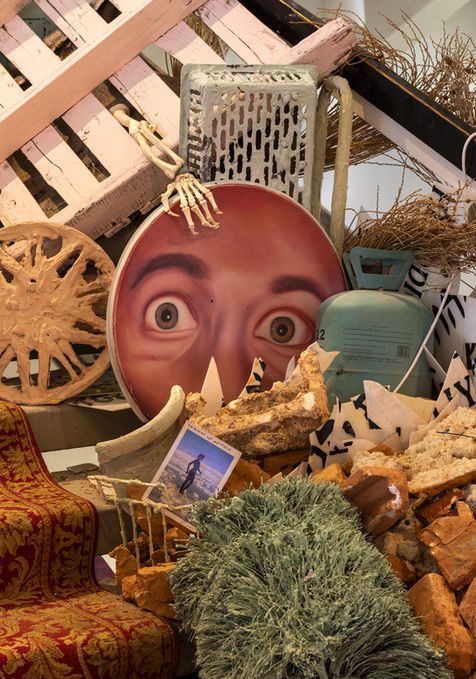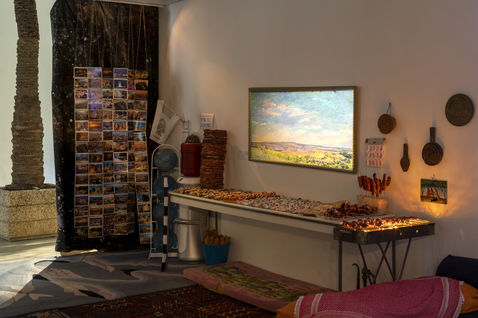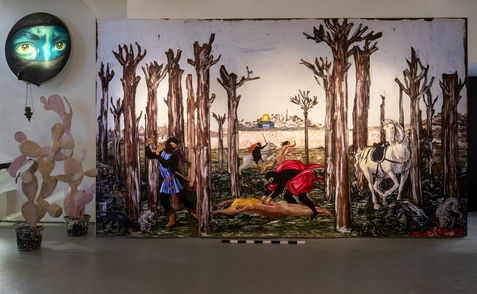
Neuland
Solo Show at The Helena Ruhbinsiet, Tel Aviv Museum of Arts, Tel Aviv, 2019
EN Tamar Hirschfeld’s video and installation works shift between the tragic and the comic and examine issues of gender and the politics of identity and post-colonialism. Over the past decade, Hirschfeld has adopted a nomadic persona, wandering around with a sense of disquiet, gazing at marginal areas and weakened populations. The exhibition features two major video installations from 2015–2019, screened within sculptural environments rich with materiality. The work screened on the ground floor is Sheldon the Humanist Skeleton )2015–2016(, depicting a fictitious affair between the artist, who was living in Lille, France, at the time, and a skeleton that she “discovered” in excavations in the Dead Sea area. It is an absurd love story between two foreigners in France, realized by puppeteers and the imagination—with a nod at the theatrical, cinematic and literary space. The complex and tangled reality of the refugee crisis, the Israeli–Palestinian conflict and the clash between nationalism and globalism is set out against the background of the rebirth of the humanist skeleton and the love story between Tamar and Sheldon, linking the personal- biographical with the historical, the political, the public. The work is screened in three sculptural environments that invite viewers to a journey through worldly, corporeal settings of a supermarket and a stalactite cave that culminate in an abysmal black space. The shift between environments in the film and the sculptural installation is linked with the perception of time in Hirschfeld’s work, articulating processes of change and renewal, a metamorphosis of the image from matter to spirit, from dead to living and vice versa. The entrance level features the video work The Cheese Butt [Chizbat or Tall Tale] )2017–2019(, viewed through a virtual-reality headset, in which three ancient worlds are juxtaposed with modern technology and global economy. The film narrates the tale of three Bedouin men stuck overnight in the desert with a broken-down car, who pass their time pleasantly around a fire with a thousand and one tales, until their car is miraculously revived. The escape from reality and the transition from the real to the imagined through the art of storytelling indirectly hint at the role of art in ongoing political crises. In the lower ground floor, one of Hirschfeld’s earlier works is screened, from the video installation Schwartze and a Brief History of Mankind )2013(, in which the artist, in the guise of a black woman, is talking to Yuval Noah Harari about his book. Schwartze was the first constitutive “mask” that defined Hirschfeld’s complex relationship between man and the world and between artist and society and replaced the focus on the individual and biographical with representation of humanity in its entirety. Through the principle of division and masking, the artist’s body signified the collapse of space and time between Africa and Europe and Israel, merged the traumas of various nations and reflected the moral dilemma regarding questions of contrition, correction )Tikkun( and atonement. The fluid, hybrid identity that the artist adopts in her works is linked with the grotesque body representations and the dialectics of crossing boundaries, characteristic of the carnivalesque. The components of carnival and grotesque are manifested in her work’s symbolic and esthetic stance: abundance and redundancy, mask and nudity, mechanisms of defamiliarization and reversal, crossing the lines between life and death, between body and soul, between sadness and laughter; all these expose the complexity of human existence as well as the false reality reflected through it. Hirschfeld presents life as a comedy and people as actors, tearing their masks off with curses while adopting the guise of the fool, happy and ridiculing, the scapegoat representing the sins of society, challenging the old order and motivating humanity towards catharsis, change, renewal and rebirth. In He Alone Stands Here )2018–2019(, the video that concludes the exhibition, the artist appears in a tragi-comic scene, hanging between heaven and earth from a date palm, accentuating her irrelevance to the reality which she represents, an eternal voyeur. Anat Danon Sivan
HEB עבודתה של הירשפלד בתחומי הווידאו והמיצב נעה בין הטרגי לקומי, ועוסקת בסוגיות של מגדר, פוליטיקה של זהויות ופוסט־קולוניאליזם. בעשור האחרון מאמצת האמנית פרסונה נוודית, משוטטת במרחב מתוך תחושת אי־נחת, ומישירה מבט לאזורי שוליים ולאוכלוסיות מוחלשות. בתערוכה שני מיצבי וידאו מרכזיים מהשנים ,2019–2015 המוקרנים בתוך סביבות פיסוליות עשירות. בקומת הקרקע מוקרנת עבודת הווידאו שלדון השלד ההומניסטי ,)2016–2015( המתארת רומן פיקטיבי בין האמנית ובין שלד שהיא ״גילתה״ בחפירות באזור ים המלח. זהו סיפור אהבה אבסורדי הנרקם בין שני זרים על אדמת צרפת, ומתממש בעזרת בובנאים וכוח הדמיון, בקריצה למרחב התיאטרלי, הקולנועי והספרותי. על רקע לידתו מחדש של השלד האנושי וסיפור אהבתם של תמר ושלדון, נפרשת מציאות סבוכה ומורכבת של משבר הפליטים, הסכסוך הישראלי־פלסטיני והקונפליקט בין לאומיות ובין גלובליזם; כל אלו נשזרים זה בזה, וקושרים את העניין האישי והביוגרפי בזה ההיסטורי, הפוליטי והציבורי. שלדון השלד ההומניסטי מוקרן בשלוש סביבות פיסוליות המזמינות את הצופה למסע בין חללים ארציים וגשמיים של סופרמרקט ומערת נטיפים, שבסופם חלל שחור תהומי. המעבר בין סביבה אחת לאחרת בווידאו ובמיצב הפיסולי קשור בתפיסת הזמן ביצירתה של הירשפלד, ומבטא תהליכי השתנות והתחדשות, מטמורפוזה של הדימוי מחומר לרוח, מחי למת, וחוזר חלילה. במפלס הכניסה מוצגת באמצעות משקפי מציאות מדומה עבודת הווידאו הצ׳יזבט ,)2019–2017( שבה מעומתים עולמות קדמונים עם טכנולוגיה מתקדמת וכלכלה גלובלית. העבודה מגוללת את סיפורם של שלושה בדואים הנתקעים עם רכבם במדבר, ומעבירים את זמנם בסיפורי אלף לילה ולילה סביב המדורה עד שרכבם מתעורר לחיים באורח פלא. ההימלטות מן המציאות והמעבר מן הממשי למדומיין דרך אמנות הסיפור, רומזים בעקיפין על תפקידה המשחרר של האמנות ביחס למציאות של משבר. בקומת המרתף מוצגת עבודת וידאו מוקדמת של הירשפלד מתוך מיצב הווידאו שוורצע וקיצור תולדות האנושות ,)2013( שבה מחופשת האמנית לדמות שחורה ומשוחחת עם פרופ׳ יובל נוח הררי על ספרו. שוורצע זכורה כ״מסכה״ הראשונה והמכוננת שניסחה את מערכת היחסים המורכבת של הירשפלד בין אדם לעולם ובין אמן לחברה, ודחקה את העיסוק באישי ובביוגרפי לטובת ייצוג כלל אנושי. דרך עיקרון הפיצול והכיסוי, סימן גוף האמנית את קיפול המרחבים והזמנים בין אפריקה ואירופה לישראל, מיזג בין טראומות של עמים שונים, ושיקף את הדילמה המוסרית ביחס לשאלות של הכאה על חטא, תיקון וכפרה. הזהות הנזילה וההיברידית שמאמצת האמנית בעבודותיה, נקשרת בייצוגי הגוף הגרוטסקי ובדיאלקטיקה של חציית הגבולות המזוהים עם מאפייני הקרנבל. מרכיבי הקרנבל והגרוטסק מתגלמים בעמדה הסימבולית והאסתטית שמציעה עבודתה: גודש ועודפות, מסכה ועירום, מנגנוני הזרה והיפוך, חציית גבולות בין חיים למוות, בין גוף לרוח, בין עצב לצחוק; אלו חושפים את מורכבות הקיום האנושי וכן את המציאות השקרית הנשקפת דרכו. הירשפלד מציגה את החיים כקומדיה ואת האנשים כשחקנים, קורעת מעליהם את המסכות בגידופים בעודה מאמצת את דמות השוטה, המשמח והמלגלג, השעיר לעזאזל, המייצג את חטאי החברה, קורא תיגר על הסדר הישן, ומניע את האנושות לקראת קתרזיס, שינוי, התחדשות ולידה מחדש. בעבודת הווידאו האחרונה שצולמה לתערוכה, הוא לבדו עומד כאן ,)2019–2018( מופיעה האמנית בסצנה קומית־טרגית, תלויה על עץ תמר בין שמיים וארץ, מדגישה את אי־שייכותה למציאות שאותה היא מייצגת, ומגדירה עצמה כמציצנית נצחית. ענת דנון סיון

























